Introduction
Nowadays, increasing the productivity of agricultural crops in a sustainable manner is one of the major global challenges (Al-Dosary et al. 2016). Barley, Hordeum vulgare L. (Poaceae) is a main food crop for millions of people in the predominantly mixed crop-livestock farming systems worldwide (FAO 2018). It is one of the fourth most important cereal crops in the world in terms of both quantity and cultivated areas (Thormann et al. 2017). In Jordan, barley is the predominant crop where the total area is estimated at 5,646 hectares in 2017 (Jordan Statistical Yearbook 2018), and it is mainly grown as animals feed, where both grain and straw are utilized (Al-Tabbal and Al-Fraihat 2012).
Hundreds of insects have been described on cereals worldwide, most of these insects cause insignificant damage, while few cause serious yield and forage reduction annually across international borders (El-Bouhssini et al. 2009; Al-Zyoud et al. 2015; Miller and Pike 2017). The cereal leafminer, Syringopais temperatella Led. (Lepidoptera: Scythrididae) is a major pest of barley in Jordan. It causes great damages through feeding on plant leaf tissues, thus restricting barley production (Ghabeish et al. 2014; Al-Zyoud et al. 2015; Al-Zyoud and Ghabeish 2015). Such yield reduction depends on infestation level, plant cultivar, predation and parasitism, soil condition, rainfall, plowing and sowing date (Jemsi and Rajabi 2003; Gozuacik et al. 2008; Al-Zyoud et al. 2009; Al-Zyoud 2012). It has one generation per year, larvae diapause for 7-7.5 months at 15-30 cm soil depth, and the larvae are active for 4-4.5 months inside wheat and other hosts.
Continuous use of chemical insecticides is neither economic nor sustainable, and poses a risk to humans and environment (Kranthi et al. 2001; Al-Zyoud 2014c). There is a growing interest in the development of innovative control strategies that may lead to a reduction of chemicals, with the aim to minimize the environmental impact of pest management and improve the safety of the agro-food chain (Ganassi et al. 2016). In many agricultural-based systems, tillage as cultural control is used to reduce pest populations (Brandenburg et al. 1998; Al-Zyoud 2013; 2014a; b), which influences directly the survival of soil inhabiting pests (Rodríguez et al. 2006; Al-Zyoud and Ghabeish 2015) by creating a physical barrier to their movement (Strnad and Bergman 1987), changing their habitat (Van Capelle et al. 2012), changing soil moisture and temperature dynamics and increasing mechanical damage (Curry et al. 2002). Reduced tillage practices could influence different pest species in different ways due to different pest life strategies (Andersen 1999). However, deep tillage has controlled many pests as compared to no- or reduced tillage, i.e. S. temperatella (Al-Zyoud and Ghabeish 2015); Sunn pest, Eurygaster integriceps Put. (Hemiptera: Scutelleridae) (Sedighi et al. 2013); the tomato borer, Tuta absoluta Meyearick (Lepidoptera: Gelechiidae) (Van der Straten 2009) and earthworms (Briones and Schmidt 2017).
Tillage could significantly affect the outcome of many crops including barley (Mamkagh 2009, 2018). In Jordan, the main used practice is the conventional tillage (Al-Issa and Samarah 2006). It alleviates of compact subsoil layer, incorporates the residue, prepares seedbed and controls soil-inhabiting pests in the field. It is based mainly on moldboard, chisel and disk plows (Mamkagh 2019). Tillage could change the soil moisture, which has a great effect on crop yield (De Vita et al. 2007).
New technologies in agriculture are needed in order to provide the world with enough food (Hosseini et al. 2010) by rapidly increasing cereal production which should be effectively addressed through modifications in the present protection and production measures (Marsh and Gallardo 2009). However, to our knowledge, little attention has been paid to the use of cultural control methodologies against S. temperatella, and we will herein report the efficacy of tillage type and depth against the pest. It was hypothesized that both tillage type and depth have a positive effect on pest population and barley production. To sum up, the specific measurable outcomes of this study might increase barley production through reducing pest infestation, resulting in increased farm incomes, and reduce hazards in rural areas associated with insecticide use, which will contribute to improving barley security in Jordan.
Materials and methods
Site, environmental conditions and growing plants
The experiments were conducted in a field known to be heavily infested by S. temperatella since 2001 in Al-Simakiyah Area located 7 km northeast of the Faculty of Agriculture, Mutah University, Karak, Jordan (latitude of 31°11″, longitude of 35°42″ and altitude of 845 m). The study was carried out during the 2019/2020 cropping season. The experimental site is characterized by semi-arid conditions with a relatively moderate rainfall (300 mm long-term annual average). The field soil was sandy clay loam with 7.78 pH, 1.28 ds/m electrical conductivity (EC) and 1.63% organic matter. Generally, rainfall is irregular with intra- and inter-seasonal variability, where most of it falls from December to February. Seeds of Mutah barley cultivar were sown during December 2019, and neither fertilizers nor insecticides were applied.
Experimental design and procedure
The experimental design was a randomized complete block design (RCBD) with three replications. In the experiments, no-tillage and conventional tillage practices were evaluated. Tillage was performed with moldboard, disk and chisel plows, for each plow three different soil depths (15, 30 and 45 cm) were evaluated. Each tillage type/depth was replicated three times, in which each replicate (plot) consisted of an area of 2-meter square (1 x 2 m), and a distance of 2 m among the different treatments was kept. Soil preparation with different tillage types and depths was conducted in September 2019, and in all treatments, except the no-tillage, a leveling disk harrow was used to level the soil slightly at a shallow depth for sowing the seeds at a rate of 20 g/plot (2 m2).
Parameters tested. Data on the percentage of infestation were independently estimated by two experts 7 (March 27th, 2020) and 14 (April 2nd, 2020) days post pest infestation (March 20th, 2020) after the initial first larval appearance through an extensive survey twice a day in all treatments, and the averages were calculated. In addition, after 7 and 14 days of pest infestation, the number of S. temperatella larvae was counted in the field from randomly selected 20 barley plants in all tillage types and depths. Digital meter with 0.1% resolution was used to measure the soil moisture at 10 cm depth in all treatments starting from the sowing date until harvesting, and the average values were calculated. Hereafter, at the harvesting stage (May 15th, 2020), all the plants in all plots; in a total of 36 plots and 9 plots/ treatment were collected from the field, and the plants of each plot were separately kept in a paper bag and brought back to the laboratory. Data were recorded for plant height of randomly selected 20 barley plants/plot, and grain yield weight and dry straw biomass from all plots.
Statistical analysis. In order to affirm the basic assumptions of the data to be analyzed, they were firstly tested for the normal distribution and the homogeneity of variance using the Barlett-test (Kohler et al. 2002). As a first step of the statistical analysis of the data after fulfilling the fore-mentioned assumptions, one and two-way analysis of variance (ANOVA) was conducted (Wilkinson 1990) to examine the effect of tillage type and depth as well as the combined effect of tillage type and depth on each of the crop/pest variables, through the Proc GLM of the Statistical Package SigmaStat version 22.0 (SPSS 1997) to detect differences among means. While differences among means were detected, the second step was to determine the significant differences among the means using least significant differences (LSD) at a probability level of 0.05 (Abacus Concepts 1991). In case of comparing between two means (time: week 1 and 2), T-test was conducted (Anonymous 1996). In addition, correlation analysis among the different parameters tested (soil moisture vs. each of plant height, grain yield and straw biomass) was calculated using Spearman’s correlation method (Zar 1999).
Results
Infestation by Syringopais temperatella
Results revealed that, within the same tillage type, there was a significant decrease in S. temperatella infestation with increasing plowing depth one- and two-weeks post infestation; moldboard (F2,9 = 8.54 and 79.8; P ≤ 0.05), chisel plow (F2,9 = 7.27 and 7.52; P ≤ 0.05) and disc plow (F2,9 = 7.69 and 68.87; P ≤ 0.05) (Fig. 1A-B). Crop infestation was significantly the lowest one week (F3,36=19.34; P ≤ 0.05) and 2 weeks (F3,36 = 10.15; P ≤ 0.05) of the infestation in all tillage types; moldboard plow (25.28 ± 8.61% and 25 ± 8.47%), disc plow (20.28 ± 7.33% and 26.94 ± 13.68%), chisel plow (31.39 ± 5.17% and 33.89 ± 8.76%) as compared to no-tillage (41.67 ± 1.76% and 48.33 ± 7.81%), respectively (Fig. 2A). The infestation was significantly (t ≤ 0.05) higher in the 2nd week than in the 1st week in no-tillage and disc plow treatments, while there were no significant differences in moldboard plow and chisel plow treatments (Fig. 2A). The infestation decreased significantly with increasing plowing depth in both 1st week (F3,36 = 28.31; P ≤ 0.05) and 2nd week (F3,36 = 36.84; P ≤ 0.05). The infestations were 41.67 ± 1.77% and 48.33 ± 7.81% (no-tillage), 31.94 ± 6.59% and 39.17 ± 7.07% (15 cm), 26.67 ± 5.00% and 29.44 ± 2.73% (30 cm), and 18.33 ± 7.07% and 17.22 ± 7.44% (45 cm) in the 1st and 2nd week, respectively (Fig. 2B). Furthermore, the infestation was significantly higher (t ≤ 0.05) in the 2nd week than in the 1st week at zero (no-tillage) and 15 cm, while there were no significant differences at 30 cm and 45 cm plowing depths (Fig. 2B). Furthermore, the combined effect of tillage type and depth on infestation was not significantly different (F4,27 = 0.698; P > 0.05) at one-week post infestation, while it was significant (F4,2 = 4.379; P ≤ 0.05) at 2 weeks post infestation.
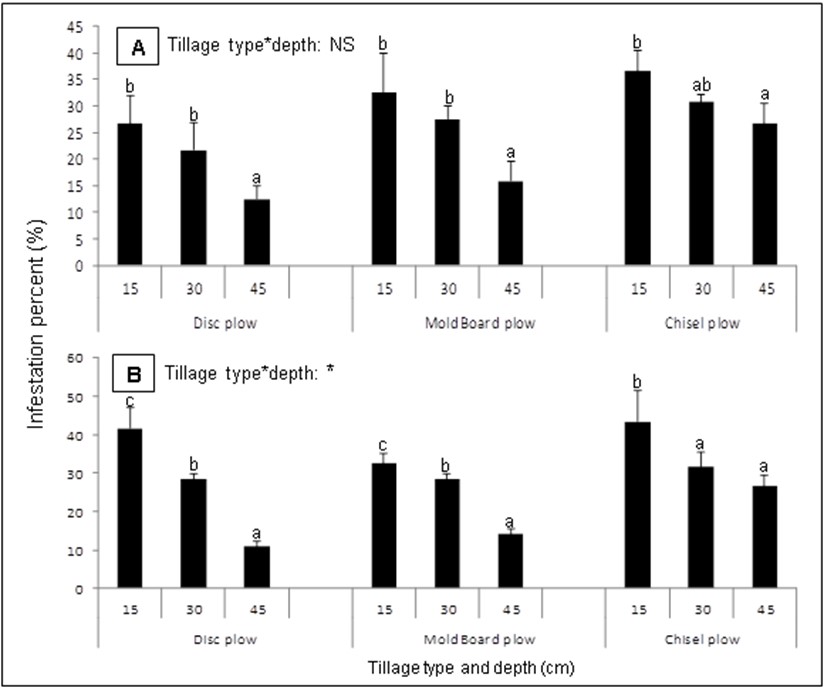
Figure 1 Average (± SD) Syringopais temperatella infestation percent on barley plants one (A) and two weeks (B) of the pest infestation after land was plowed by different tillage types at different depths. [Different letters above bars indicate significant differences among tillage depths within the same tillage type and week at P ≤ 0.05, one-factor analysis of variance]. *: Indicates significant differences, while NS: Indicates non-significant differences of the combined effect of tillage type and depth at P ≤ 0.05 (Two-way analysis of variance).
Number of Syringopais temperatella larvae.
Results demonstrated that, within the same tillage type, there was a significant decrease in number of larvae with increasing plowing depth after one and two weeks of infestation (Fig. 3A-B); moldboard (F2,9 = 36.81 and 20.26; P ≤ 0.05), chisel plow (F2,9 = 3.19 and 19.26; P ≤ 0.05), and disc plow (F2,9 = 11.04 and 46.25; P ≤ 0.05). Number of larvae was significantly the lowest one week (F3,36 = 2.61; P ≤ 0.05) and 2 weeks (F3,36 = 18.44; P ≤ 0.05) post infestation in all tillage types; moldboard plow (27.56 ± 11.66 and 22.22 ± 8.19), disc plow (31.78 ± 12.43 and 23.67 ± 8.51), chisel plow (30.56 ± 8.47 and 25.44 ± 8.09) compared with no-tillage (40.33 ± 7.22 and 46.33 ± 6.81), respectively (Fig. 4A). As shown in Figure 4A, there were no significant differences in the number of larvae between the 1st and 2nd weeks in the four tillage types. The number of larvae decreased significantly with increasing plowing depth in both 1st week (F3,36 = 14.62; P ≤ 0.05) and 2nd week (F3,36 = 63.92; P ≤ 0.05). The numbers of larvae were 40.33 ± 7.23 and 46.33 ± 6.82 (no-tillage), 36.89 ± 7.42 and 31.78 ± 3.86 (15 cm), 34.00 ± 7.79 and 24.56 ± 4.67 (30 cm), and 19.00 ± 7.04 and 15.00 ± 3.87 (45 cm) in the 1st and 2nd week, respectively (Fig. 4B). In addition, the same figure showed that the number of larvae was significantly (t ≤ 0.05) higher in the 2nd week than in the 1st week at all depths except at 45 cm. Moreover, the combined effect of tillage type and depth on larval number was significantly different at one-week (F4,27 = 4.427; P ≤ 0.05), and 2 weeks (F4,27 = 4.916; P ≤ 0.05) post infestation.
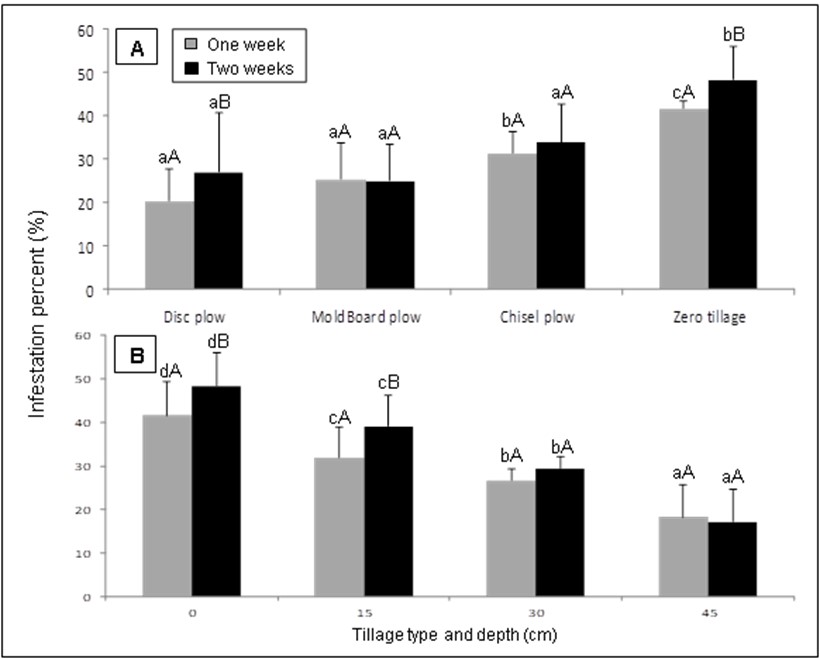
Figure 2 Average (±SD) Syringopais temperatella infestation percent on barley plants one and two weeks of the pest infestation after land was plowed by different tillage types (A) at different depths (B). [Different small letters above bars indicate significant differences among tillage types (A) or tillage depths (B) within the same week, while different capital letters above bars indicated significant differences between weeks within the same tillage type and depth at P ≤ 0.05, one-factor analysis of variance].
Plant height. Data indicated that, within the same tillage type, there was significant increase in plant height with increasing plowing depth; moldboard (F2,180 = 392.91; P ≤ 0.05), chisel plow (F2,180 = 31.01; P ≤ 0.05), and disc plow (F2,180 = 116.84; P ≤ 0.05) (Fig. 5A). Barley plants were significantly (F3,720 = 107.28; P ≤ 0.05) the tallest when the moldboard plow was used (68.71 ± 17.22 cm), followed by chisel plow (63.89 ± 5.71 cm), disc plow (61.1 ± 11.18 cm), and then no-tillage (48.88 ± 6.26 cm) (Fig. 5B). Plant height increased significantly (F3,720 = 358.48; P ≤ 0.05) with increasing tillage depth, in which they were 48.88 ± 5.11 cm, 55.00 ± 8.41 cm, 62.51 ± 6.81 cm and 76.19 ± 11.61 at zero (no-tillage), 15 cm, 30 cm and 45 cm depths, respectively (Fig. 5C). The combined effect of tillage type and depth on plant height was not significantly different (F1,540 = 2.650; P > 0.05).
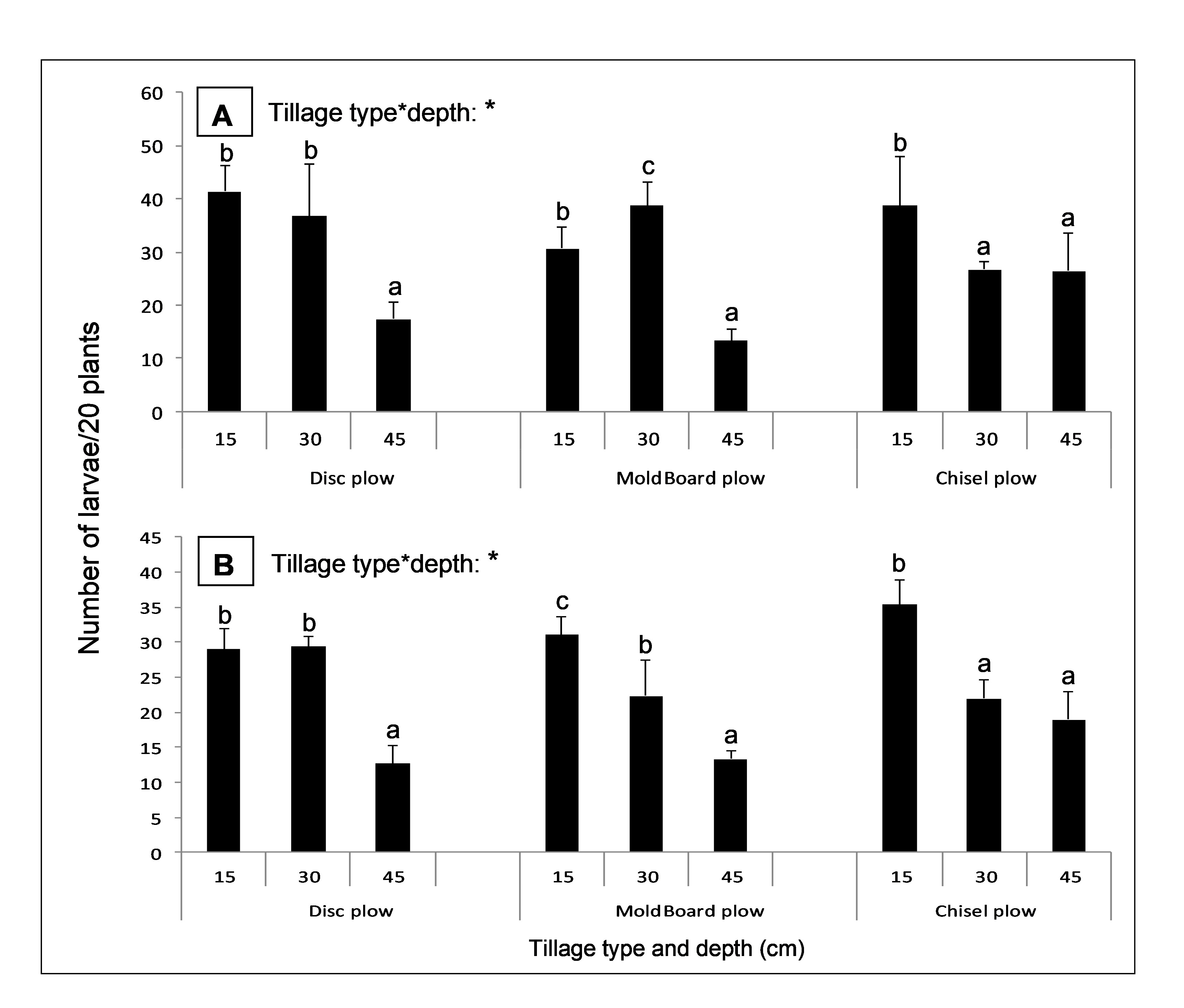
Figure 3 Average (±SD) Syringopais temperatella number of larvae on barley plants one (A) and two weeks (B) of the pest infestation after land was plowed by different tillage types at different depths. [Different letters above bars indicate significant differences among tillage depths within the same tillage type and week at P ≤ 0.05, one-factor analysis of variance]. *: Indicates significant differences of the combined effect of tillage type and depth at P ≤ 0.05 (Two-way analysis of variance).
Grain yield. Data showed that, within the same tillage type, there was significant increase in grain yield with increasing plowing depth; moldboard (F2,9 = 29.11; P ≤ 0.05), chisel plow (F2,9 = 27.62; P ≤ 0.05), and disc plow (F2,9 = 39.52; P ≤ 0.05) (Fig. 6A). Barley grain yield in moldboard plow treatment (409.33 ± 125.88 g/plot) was significantly (F3,36 = 9.18; P ≤ 0.05) the highest than those in the three other tillage treatments. The grain yield was then significantly decreased in the following order: disc plow (380 ± 89.31 g/plot); chisel plow (322.89 ± 66.92 g/plot) and no-tillage (215.44 ± 20.03 g/plot) (Fig. 6B). Grain yield in the treatment at 45 cm tillage depth (484.11 ± 80.44 g/plot) was significantly (F3,36 = 53.55; P ≤ 0.05) the highest followed by 347.33 ± 33.55 g/plot at 30 cm, 280.78 ± 29.51 g/plot at 15 cm and 215.44 ± 20.03 g/plot in no-tillage treatment (Fig. 6C). The combined effect of tillage type and depth on grain weight was not significantly different (F6,36 = 0.048; P > 0.05).
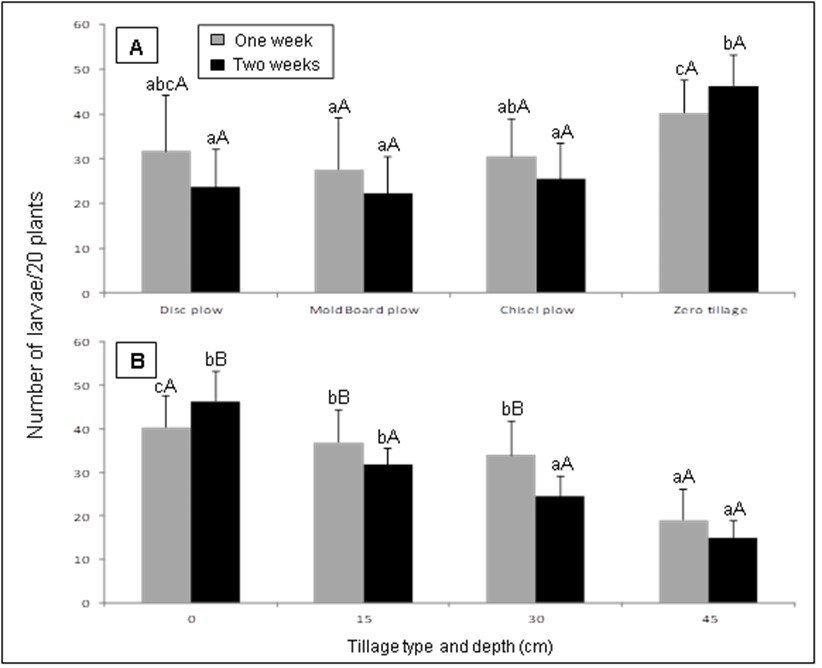
Figure 4 Average (± SD) Syringopais temperatella number of larvae on barley plants one and two weeks of the pest infestation after land was plowed by different tillage types (A) at different depths (B). [Different small letters above bars indicated significant differences among tillage types (A) or tillage depths (B) within the same week, while different capital letters above bars indicate significant differences between weeks within the same tillage type and depth at P ≤ 0.05, one-factor analysis of variance].
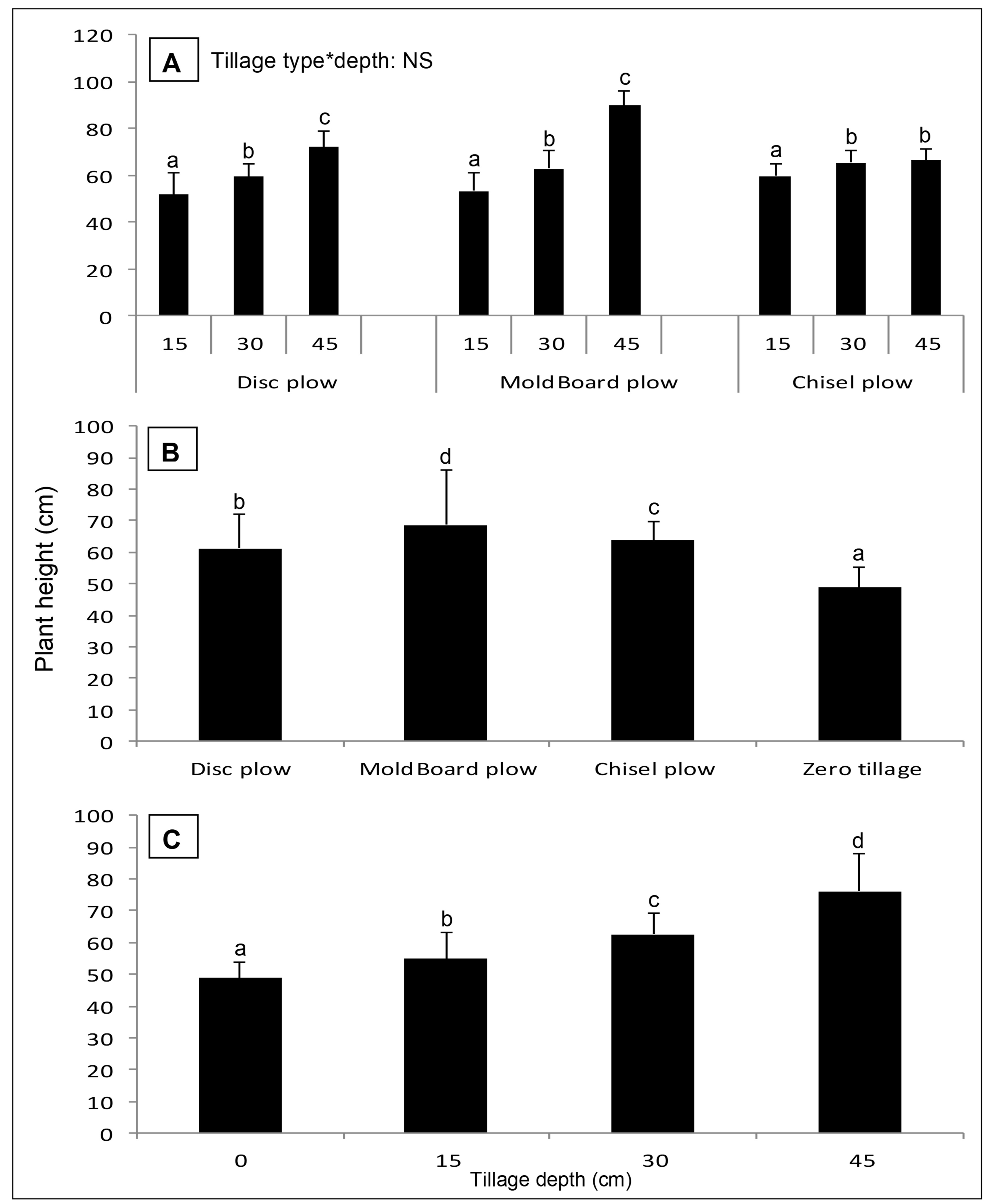
Figure 5 Average plant height (± SD) of barley plants infested with Syringopais temperatella after land was plowed by different tillage types at different tillage depths (cm) (A), different tillage types (B) and at different tillage depths (C). [Different letters above bars indicate significant differences among tillage depths within the same tillage type (A) or among tillage types (B) or different tillage depths (C) at P ≤ 0.05, one-factor analysis of variance]. NS: Indicates non-significant differences of the combined effect of tillage type and depth at P ≤ 0.05 (Two-way analysis of variance).
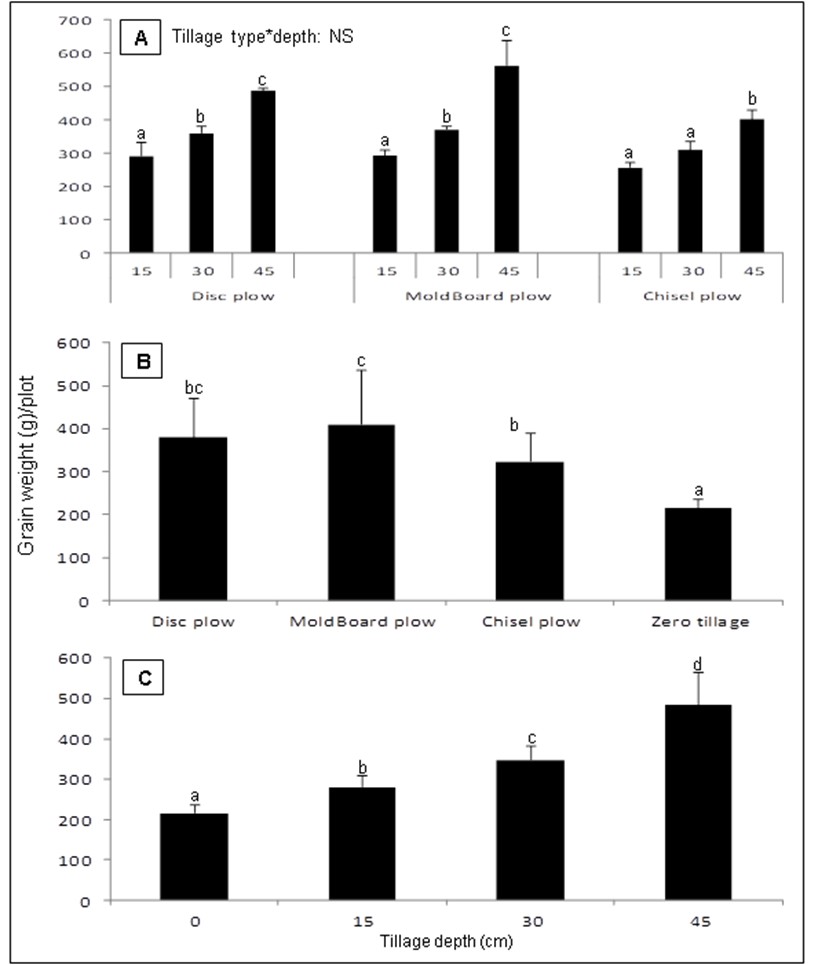
Figure 6 Average grain weight (± SD) of barley plants infested with Syringopais temperatella after land was plowed by different tillage types at different depths (cm) (A), different tillage types (B) and at different tillage depths (C). [Different letters above bars indicate significant differences among tillage depths within the same tillage type (A) or among tillage types (B) or different tillage depths (C) at P ≤ 0.05, one-factor analysis of variance]. NS: Indicates non-significant differences of the combined effect of tillage type and depth at P ≤ 0.05 (Two-way analysis of variance).
Straw biomass. Results revealed that, within the same tillage type, there was significant increase in straw biomass with increasing plowing depth; moldboard (F2,9 = 7.3; P ≤ 0.05), chisel plow (F2,9 = 6.1; P ≤ 0.05), and disc plow (F2,9 = 2.37; P ≤ 0.05) (Fig. 7A). Straw biomass (1060.56 ± 249.19 g/plot) was significantly (F3,36 = 6.06; P ≤ 0.05) higher when the moldboard was used compared with the other tillage treatments, and then it significantly decreased in the order; disc plow (1021.67 ± 227.12 g/plot); chisel plow (904.44 ± 96.58 g/plot), and then no-tillage (736.11 ± 55.27 g/plot) (Fig. 7B). There were significant (F3,36 = 16.61; P ≤ 0.05) differences in the straw biomass among the different depth treatments, in which the highest straw biomass was recorded at 45 cm (1175 ± 194.07 g/plot), followed by 970 ± 183.91 g/plot at 30 cm, while the lowest straw biomass was reported at 15 cm (841.67 ± 52.73 g/plot) and no-tillage (736.11 ± 55.27 g/plot) treatments which were at bar with each other (Fig. 7C). The combined effect of tillage type and depth on straw biomass was not significantly different (F1,540 = 2.650; P > 0.05).
Soil moisture. Data demonstrated that soil moisture percentage was significantly higher (F3,316 = 4.67; P ≤ 0.05) when the moldboard (30.93 ± 7.86%) and chisel (30.92 ± 8.33%) plows were used, which were more than the disc plow (27.60 ± 6.58%) and no-tillage (27.91 ± 7.45%) (Fig. 8A). Results also showed a positive effect of tillage depth on soil moisture, where it was significantly high (F3,790 = 3.84; P ≤ 0.05) at 45 cm depth (31.31 ± 10.17%). On the other hand, no significant differences were found in soil moisture among the no-tillage, 15 cm and 30 cm tillage depths (Fig. 8B). The combined effect of tillage type and depth on soil moisture was significantly different (F4,711 = 7.166; P ≤ 0.05).
Correlation analysis. Correlation analysis indicate that soil moisture is correlated positively and significantly with each of plant height (r = 0.980, P < 0.05), grain weight (r = 0.985, P < 0.05), and straw biomass (r = 0.975, P < 0.05) (Table 1).
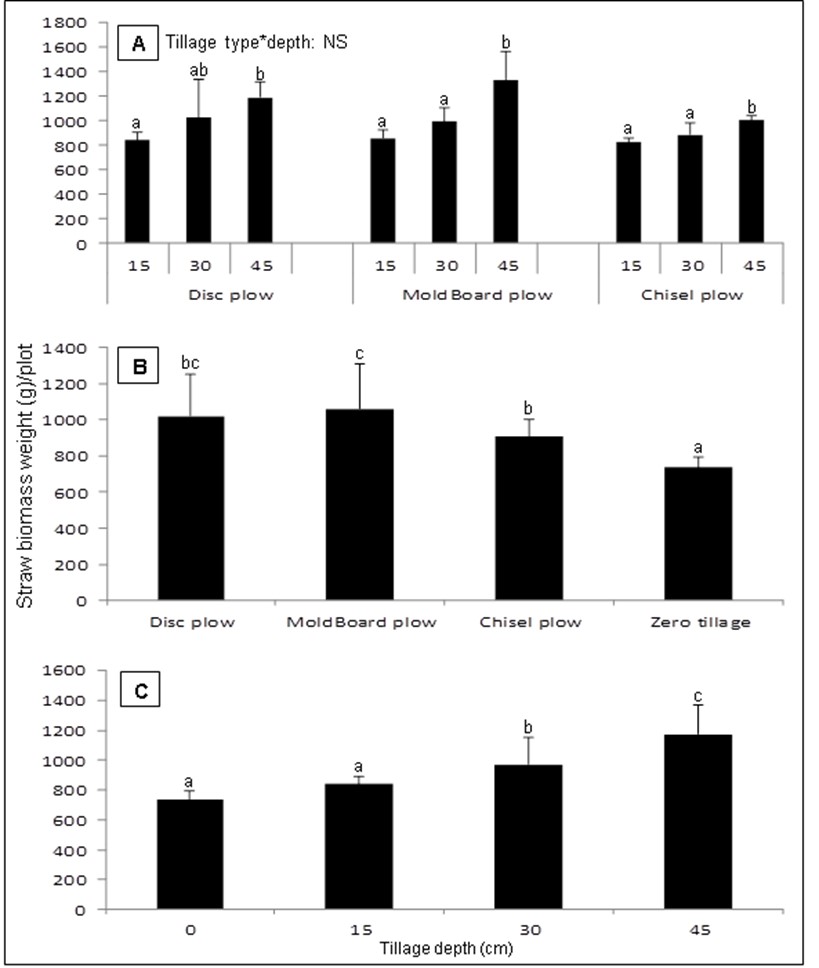
Figure 7 Average straw biomass (±SD) of barley plants infested with Syringopais temperatella after land was plowed by different tillage types at different depths (cm) (A), different tillage types (B) and at different tillage depths (C). [Different letters above bars indicate significant differences among tillage depths within the same tillage type (A) or among tillage types (B) or different tillage depths (C) at P ≤ 0.05, one-factor analysis of variance]. NS: Indicates non-significant differences of the combined effect of tillage type and depth at P ≤ 0.05 (Two-way analysis of variance).
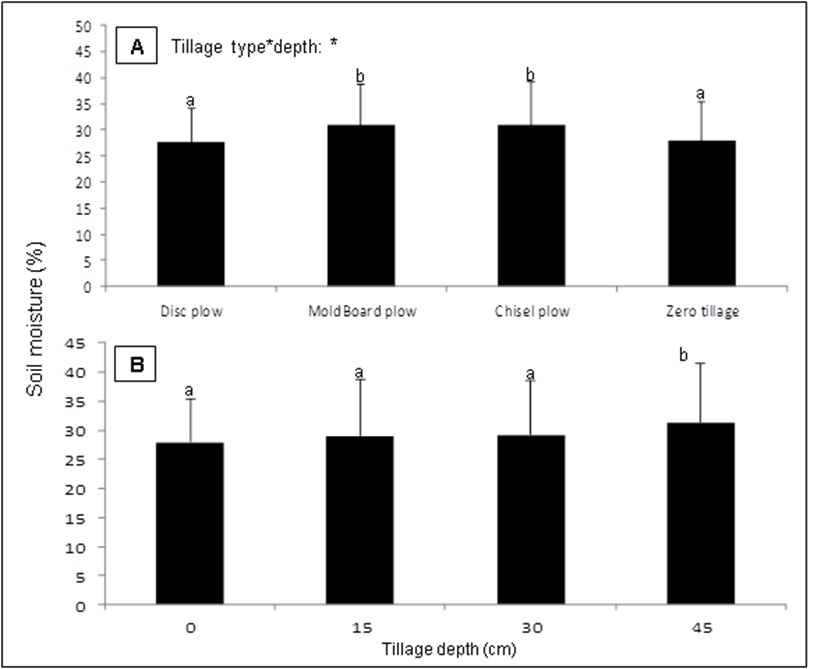
Figure 8 Average soil moisture (± SD) of land plowed by different tillage types (A) at different tillage depths (B) planted with barley infested with Syringopais temperatella. [Different letters above bars indicate significant differences among tillage types (A) or different tillage depths (B) at P ≤ 0.05, one-factor analysis of variance]. *: Indicates significant differences of the combined effect of tillage type and depth at P ≤ 0.05 (Two-way analysis of variance).
Table 1 Correlation analysis between soil moisture and each of plant height, grain weight and straw biomass of barley plant gown under different tillage systems.
| Correlated variables | R value | Significance |
|---|---|---|
| Soil moisture vs. plant height | 0.980** | 0.020 |
| Soil moisture vs. grain weight | 0.984** | 0.016 |
| Soil moisture vs. straw biomass | 0.975** | 0.025 |
**Correlation is significant at the 0.01 level.
Discussion
Resistance to pesticides and public concern about environmental impact have stimulated agricultural practitioners to change their pest management (Van Leeuwen et al. 2010). Modifications in plant production and protection measures should be effectively addressed to meet the increasing food demands (Marsh and Gallardo 2009). Cultural measures are an important tool in pests' management (Manrakhan and Lux 2008). Tillage could significantly affect the outcome of many crops (Mamkagh 2009; 2018), and could also affect soil pests (Cherry and Sandhu 2020). Strictly selection of tillage system and depth is an effective way to control pests (Al-Zyoud and Ghabeish 2015). S. temperatella is a major concern for farmers as it is the most destructive pest of barley in Jordan (Al-Zyoud 2013; Ghabeish et al. 2014; Al-Zyoud et al. 2015). The current results revealed that S. temperatella infestation and number of larvae attacking barley plant were significantly the lowest in moldboard plow followed by disc plow and chisel plow, while it was the highest in no-tillage practice, and they decreased significantly with increasing plowing depth up to 45 cm. The pest infestation decreased by about 165% after the first week of its larval appearance and by 193% after two weeks in the case of plowing with a moldboard compared to no tillage. Upon reaching a plowing depth of 45 cm (moldboard), the pest infestation decreased by about 228% after one week and by 281% after two weeks from the start of larval activity compared to no tillage. Tillage has been used to reduce pest population (Brandenburg et al. 1998; Al-Zyoud 2014a; b), it can affect soil inhabiting pests through habitat changes (Van Capelle et al. 2012), moisture and temperature dynamics (Zhao et al. 2018) and mechanical damage to pest individuals (Curry et al. 2002). Deep tillage influences directly the survival of soil inhabiting pests (Rodríguez et al. 2006; Al-Zyoud and Ghabeish 2015) by creating a physical barrier to pest movement in the soil (Strnad and Bergman 1987), and help in controlling many pests as compared to no-tillage, i.e. S. temperatella (Al-Zyoud and Ghabeish 2015). In Jordan, field observations indicate that after S. temperatella larvae hatched in May, they descend into the soil, and form cysts in which they aestivated during summer, autumn and part of the winter as first larval instar (Al-Zyoud 2007). The larval population size in the soil could greatly affect the pest infestation and crop production. Al-Zyoud and Ghabeish (2015) found that the number of diapaused larvae increased with increasing soil depth from zero up to 40 cm, in which the highest number of diapaused larvae found at 30-40 cm depth. Al-Zyoud (2012) reported a positive correlation between the pest infestation and the number of diapaused larvae in the soil, thus reducing larval population in the soil will reduce the pest infestation. In Iran, tillage treatment done up to late August was effective in reducing S. temperatella infestation (Jemsi and Rajabi 2003). Thus, based on the findings of Al-Zyoud and Ghabeish (2015) and the current results, plowing soil at a depth up to 45 cm will be of great benefit in S. temperatella control; since it will bring up the diapaused larvae to the soil surface and exposed to natural mortality factors such as predators, and to unfavorable environmental conditions, as well as it will disturb the niche of the diapaused larvae. Based on number of larvae/ tiller, the pest economic threshold in non-irrigated and irrigated wheat field in Iran were on average 2.47 and 4.05, respectively (Jemsi et al. 2002). Furthermore, in soybean, pest populations are less abundant in conventional tillage than no-tillage (Silva and Klein 1997). The pest population in the plots tilled with moldboard plow, disk plow and chisel plow were significantly lower than in the no-tillage plots (Oliveira et al. 2000). This confirmed the hypothesis raised by Oliveira (1997), in which the efficiency of soil tillage upon Phyllophaga cuyabana (Moser) (Coleoptera: Melolonthidae) larvae should be related to the depth reached by the machine and the localization of larvae in the area. Studies performed by Oliveira and Hoffmann (1996) indicated that the population of white grubs was reduced only where the plowing reached the deeper soil layers. Moreover, reducing tillage intensity promotes earthworm abundance (Briones and Schmidt 2017), and the earthworm abundance was significantly higher (around 90%) under reduced tillage when compared with moldboard plowing (Moos et al. 2017).
The present results demonstrated that plant height, grain yield and straw biomass were significantly higher when the moldboard plow was used, followed by chisel plow and/or disc plow, and then no-tillage. Plant height, grain yield and straw biomass were increased significantly with increasing tillage depth up to 45 cm. This result is in agreement with the findings of Li et al. (2007), who reported that conventional tillage significantly increased grain yield of wheat (higher spike number and grain weight) compared to no-tillage treatment. Comparing to no-tillage, deep tillage improves wheat yield and higher spike number (Meena et al. 2013; Guan et al. 2015). Khurshid et al. (2006) found that higher grain of maize planted in deep tilled soil compared to light tillage. Furthermore, deep tillage could alleviate high subsoil strength, facilitating deeper rooting and, thus, the plant-availability of subsoil resources. In this study deep tillage led to an increase in barley productivity; and this might be due to the fact that the disruption of the root-restricting soil layers and enhancement of the soil water storage and improvement of the soil fertility, which agrees with the findings of Schneider et al. (2017), who concluded that deep tillage could destroy barriers to root growth and facilitate uptake of growth resources from the subsoil.
Correlation analysis indicated that soil moisture is correlated positively and significantly with plant height, grain weight and straw biomass. These results confirm that of De Vita et al. (2007), in which soil moisture has a great effect on crop yield. The highest soil moisture obtained in this study is due to that soil tilled by moldboard had greater infiltration rates which might result of some fractures in the soil structure created by moldboard plow (Zhao et al. 2018). These results agree with those of Blanco-Canqui et al. (2017), who indicated that the moldboard plowed-soil had greater ponded infiltration rates and cumulative infiltration, which leads to a positive effect on soil moisture. Plowing soil make it more porous (less rainfall runoff than no-tillage), therefore, the infiltration rate will increase unlike untilled soil. Furthermore, tillage practices decrease bulk density and disturb compacted soil layers and support water and solute movement and soil aeration (USDA 2008). So, the reason for the superiority of the conventional tillage in this study could be due to the lower bulk density of the plowed soil plots. High bulk density can limit the distribution of roots in the upper soil profile and root downward progression (Mosaddeghi et al. 2009), which could be a possible reason for the decrease in soil moisture and barley yield and straw in this study. The reduction in barley productivity in the no-tillage treatment herein might be due to the decrease in root absorption of soil nutrients and water because of the increase in soil bulk density, hence lower yield, which agreed with the findings of Martínez et al. (2008). Moreover, when the moldboard plow was used, the plant residue was mixed with soil and used as organic fertilizer after their decomposition, unlike in no-tillage. Moisture loss by evaporation can be one of the reasons for reducing productivity in the no-tillage soil.
Conclusion
In conclusion, this work is the first to tackle tillage system to control S. temperatella. Our findings originated from a one-year analysis under semiarid conditions, sandy-clay loam soils and low SOM in a barley monocrop system. Results of this study showed a reduction in pest infestation and increase in barley production under the impact of tillage type and depth. Herein the superiority of conventional tillage over no-tillage and deep tillage over shallow one is clearly noted in term of barley yield specifically under the study conditions. The better results were obtained when the conventional tillage is used at a depth close to 45 cm instead of no-tillage, especially if a moldboard plow used to prepare the soil for barley growth and pest control. It is hoped that the outcomes of this study could suggest an appropriate low-cost and environmentally sound control approach with minimum use of chemicals to this pest. Finally, the specific measurable outcomes of this study could contribute to improve food security in the country where barley is major sources of animals’ feed. Follow-up assays are needed that are run over longer time horizons and/or longitudinal studies across a broad range of barley crop systems.















